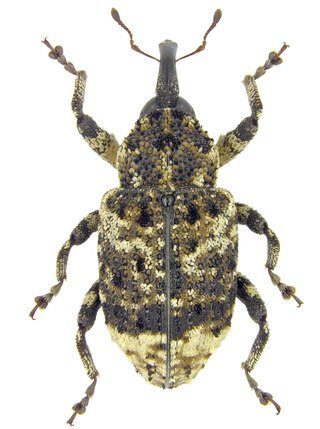
The Curculionidae are a family of weevils, commonly called snout beetles or true weevils. They are one of the largest animal families with 6,800 genera and 83,000 species described worldwide. They are the sister group to the family Brentidae.

Weevils are beetles belonging to the superfamily Curculionoidea, known for their elongated snouts. They are usually small – less than 6 mm in length – and herbivorous. Approximately 97,000 species of weevils are known. They belong to several families, with most of them in the family Curculionidae. It also includes bark beetles, which while morphologically dissimilar to other weevils in lacking the distinctive snout, is a subfamily of Curculionidae. Some other beetles, although not closely related, bear the name "weevil", such as the biscuit weevil, which belongs to the family Ptinidae.

The beetle subfamily Curculioninae is part of the weevil family Curculionidae. It contains over 23,500 described species in 2,200 genera, and is therefore the largest weevil subfamily. Given that the beetle order (Coleoptera) contains about one-quarter of all known organisms, the Curculioninae represent one of the – if not the – most successful radiations of terrestrial Metazoa.

Cryptorhynchinae is a large subfamily of weevils (Curculionidae), with some 6000 species. They are found in most zoogeographic regions although they are most diverse in the Neotropics, Australia and Oceania.

Hadramphus, commonly known as knobbled weevils, is a genus of flightless molytine weevils from the family Curculionidae. It is endemic to New Zealand and consists of four species.

Rhamphini is a weevil tribe in the subfamily Curculioninae.
Lissorhoptrus is a genus of rice water weevils in the family of beetles known as Erirhinidae. There are at least 20 described species in Lissorhoptrus.
Episcirrus is a genus of hidden snout weevils in the beetle family Curculionidae. There are at least four described species in Episcirrus.
Oligolochus is a genus of flower weevils in the beetle family Curculionidae. There are about 12 described species in Oligolochus.
Diorymeropsis is a genus of flower weevils in the beetle family Curculionidae. There are about 11 described species in Diorymeropsis.
Neoerethistes is a genus of true weevils in the beetle family Curculionidae. There are more than 30 described species in Neoerethistes. The only species in North American north of Mexico is Neoerethistes arizonicus, found in the southwestern United States.
Caulophilus is a genus of true weevils in the beetle family Curculionidae. There are more than 20 described species in Caulophilus.
Centrinites is a genus of flower weevils in the beetle family Curculionidae. There are about 19 described species in Centrinites.
Micromimus is a genus of true weevils in the beetle family Curculionidae. There are about 18 described species in Micromimus.
Pseudocentrinus is a genus of flower weevils in the beetle family Curculionidae. There are about nine described species in Pseudocentrinus.
Hilipinus is a genus of pine weevils in the beetle family Curculionidae. There are at least 50 described species in Hilipinus.
Pseudomus is a genus of hidden snout weevils in the beetle family Curculionidae. There are more than 20 described species in Pseudomus.
Stenomimus is a genus of true weevils in the beetle family Curculionidae. There are more than 30 described species in Stenomimus.
William Dwight Pierce was an American entomologist.

Pantomorus is a genus of broad-nosed weevils in the beetle family Curculionidae. There are more than 40 described species in Pantomorus.







